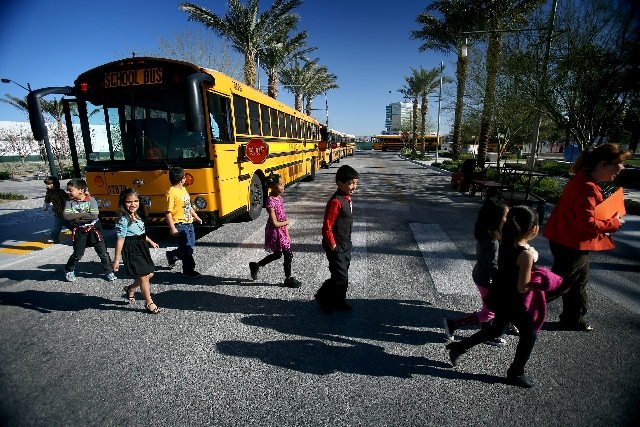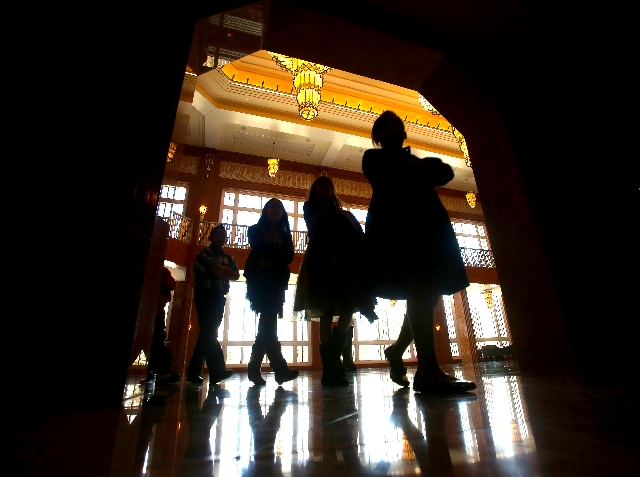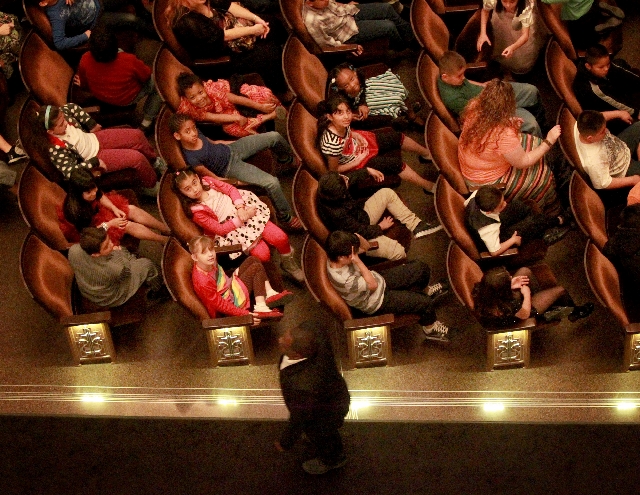The Smith Center evolves as gateway to enrichment for area students
Tears slide down the cheeks of several middle school students sitting in the dark who stay quiet for more than an hour, just looking and listening.
A mother describes doing laundry for her son, who is in the veterans hospital. While folding his clothes, she can only find one sock. She looks everywhere for it — under the bed, around the washing machine.
“Then it hit me like a punch to the gut,” she says. “There was no other sock. There was no other foot. There was no other leg.”
A young soldier tells the student audience, “Did I tell you that I got shot at by a kid? I got a real twisted view of the world right now. I don’t think I have the moral flexibility for this job.”
Leavitt Middle School teacher Victoria Ligon could have let the lesson on America’s involvement in Iraq and Afghanistan stop in the classroom.
But the choir teacher and drama club coach at the northwest valley school jumped at the invitation to take students to The Smith Center for the Performing Arts this month to see professional actors in a private showing of the understated play “Letters Home.” As the actors became the soldiers who wrote letters home, sometimes dying before returning, Leavitt students were drawn into the torment endured and the bonds formed in war.
“These are opportunities my students would never have otherwise, never,” said Ligon, who now constantly checks her email for another invitation from The Smith Center, which offers private shows to Clark County School District students and chances to participate in sound checks at the $470 million center.
Such cultural enrichment opportunities for Clark County’s 311,000 students blossomed when The Smith Center opened a year ago.
“The arts are collaborative, analytical and require critical thinking, everything we want education to be,” said Candy Schneider, the center’s vice president of education and outreach.
In the short time since its opening in March 2012, the center’s five-acre campus has welcomed 657 school buses that brought 42,287 students to watch or participate in performances.
The center has funded the cost of such opportunities through donations. All schools have to do is cover the cost of transportation.
On Tuesday , more than 2,000 elementary school students filled the center’s main theater for a play based on the children’s book “Stinky Cheese Man,” which puts a weird twist on classic children’s fairy tales. Just walking into the lavish, art-deco theater is magical, Schneider said.
“They see the balconies, the chandelier, all the beautiful seats. And one of them is theirs,” she said.
Long before the center was built, School district officials realized the benefit it could be for local students of all ages.
In 2008, the Clark County School Board approved a $5 million contribution to the center’s construction in exchange for it offering educational programs for students and professional development for teachers.
In its inaugural year, the center has trained 720 teachers. Even teachers outside the arts, such as those in math and science, have been shown how to incorporate entertainment techniques into their lessons to keep students engaged.
The goal is to have students from all Clark County schools come to the center, but that’s easier said than done with 357 schools, said Beverly Mason, director of the district’s School-Community Partnership Program.
Even so, students from as far as Mesquite — 80 miles away — have visited the center and covered the transportation costs within their school budgets, she said. Not one school has had to cancel a visit because it couldn’t find the money.
Principals see the value of exposing students to the center and arts, Mason said.
“The students are so excited,” she said. “I love how they dress in their best.”
“Letters Home” was definitely a more intense experience than students usually have at the center.
“I never knew what it was really like, the war,” said Leavitt seventh-grader Paula Davis, who was surprised at what young American soldiers have to do and see. “Kids run in front of them, but they can’t stop for fear of ambushes and have to run them over.”
Parents were required to give permission for students to see the play.
And the students were better for having experienced it, their teacher said.
“The arts are a way of teaching,” Ligon said. “You heard the comments, and these are middle school kids. They can read about it in a book, but ...”
Contact reporter Trevon Milliard at tmilliard@review journal.com or 702-383-0279.
























